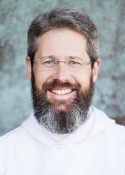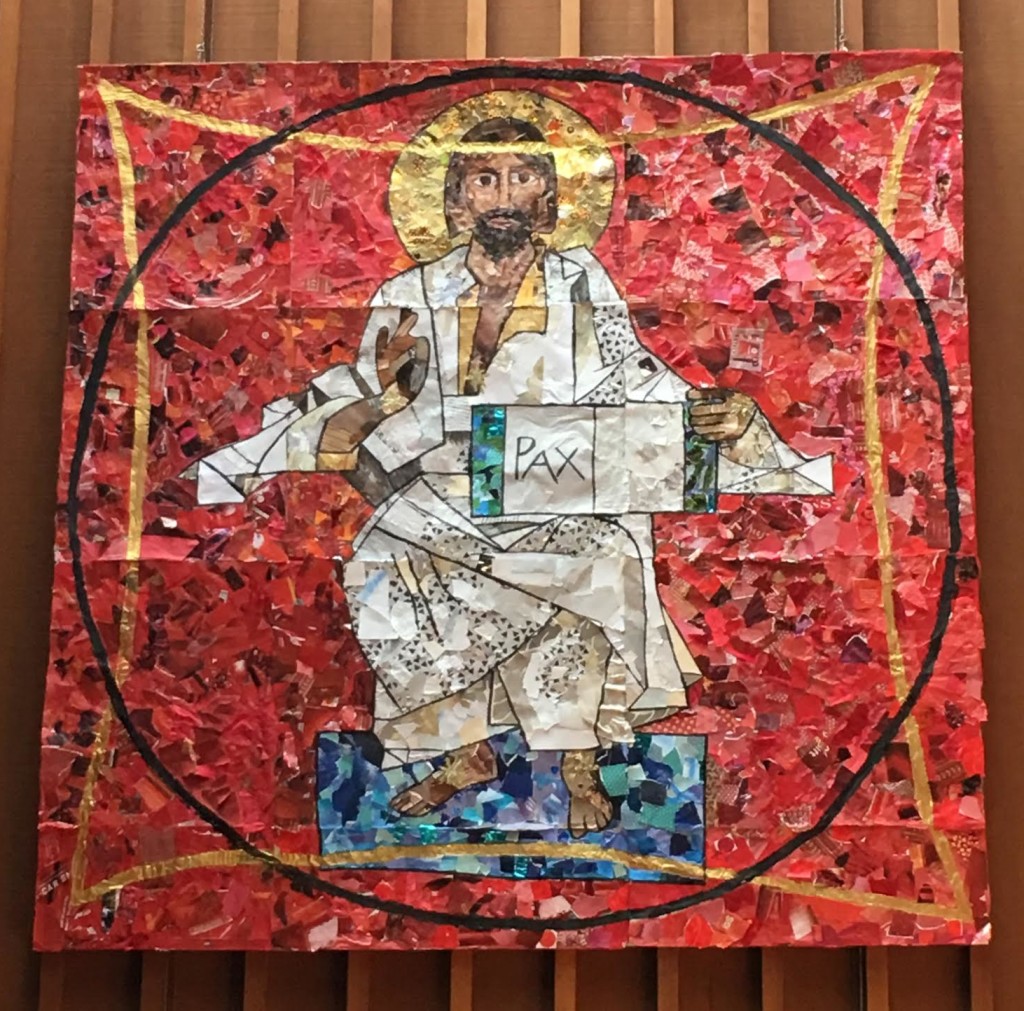FROM THE RECTOR
Learning by Walking
In the last couple of years at All Souls we have begun to notice a trend—that more and more people are coming to the parish from non-liturgical churches (non-denominational, Pentecostal, etc), as well as those who have not grown up in a Christian tradition. To be sure, this is not a new phenomenon, as Robert Webber described this trend in his 1989 book Evangelicals on the Canterbury Trail.
But as the number of folks who don’t have experience in a liturgical tradition has increased, it has brought to the surface the question that every community should be asking itself on a regular basis: why do we do what we do? While this applies to all aspects of our common life at All Souls, from budgeting to hospitality to justice and peace work, today I’ll be considering one of the primary ways that we are transformed in a Christian community—worship.
As I’ve shared before, since seminary I have kept a 3×5 card up next to my desk with a phrase that Cyprian of Carthage first wrote in the year 254. It reads, “Custom without truth is simply old error.” This is not to say that tradition is to be cast aside for whatever is new. In fact, passing down meaningful practices from generation to generation is part of what gives coherence to our lives. Living in a tradition reminds us that we do not exist simply in this day. We are recipients, participants, in a long line of people seeking to live a righteous life on this earth.
But it is to say that the “way we’ve done it before” is not a sufficient reason to continue on a particular path. This truth came clear as part of a Catechumenate class this past spring. As you may know, every Lent for a couple of decades at least, we have gathered together a group of people seeking to learn and practice anew. They meet weekly, engaging a mixture of teaching, reflection, prayer, and practice. Often the group is made up of newcomers to the parish, and this past year there were a number of those without experience in a liturgical tradition.
So the teachers of the Catechumenate (Emily Hansen Curran, Stephan Quarles, and Andrew Lee) offered a “walk through worship service,” in that they led the group through a Sunday Eucharist, stopping to answer any and all questions along the way. It even included a visit to the Sacristy, answering questions about all of the wondrous and strange objects that they came across. It ended up being one of the more engaging and meaningful sessions of the course.
As the Adult Formation team began to consider this year’s teachings on Sunday mornings, we came back to that experience in the Catechumenate. Because even if you have practiced your Christian faith in an Episcopal church for decades, my guess is that you still have questions. Questions like, Why do we sit for a reading from, say Exodus or Romans, but stand for a reading from Matthew? Why is this church built the way it is? Why was it changed? Why do we say the Creed every Sunday? What’s the deal with the actions that priests take at the Altar, since they seem to differ from priest to priest? Why do we face the back of the church at the end of the service?
With all of these questions in mind (and many more), we have created this year’s Sunday morning arc. And I am very excited about it. For the first four weeks and the last four weeks of the academic year we will be walking through the liturgy with the Rev. Dr. Ruth Meyers, me, and others as our guides. And, all of the classes that we will offer in between, from October through April, will take a moment from the liturgy and explore it in depth. With our assembled team of theologians, art historians, evangelists, environmental attorneys, scholars, and yes, even priests, we will engage the liturgy as it is intended to be—the work, the livelihood, of the people.
Come, week by week, and walk with us. My belief is that the way you think, the way you pray, and the way you live will be changed.
Peace,
Phil+
From the Associate for Ministry Development
The Return of Soup & Story
The proof is in the pudding—that’s what they say, right? Well, whatever it is, it seems that Soup & Story was a hit. How much of a hit, you may wonder? I’ll tell you. Our average Sunday attendance during Lent this past year was about 281. We had, on average, 120 people attending Soup & Story this past year. That’s 43% of the average Sunday attendance! Not only that, but of the 120 person average, 37% of you filled out an evaluation form indicating how you felt about Soup & Story; 42% of those responders went to all five nights of the group meeting and over half of those rated their overall experience as as a five out of five. Only four people of those who did an evaluation form gave a score of 3 or below.
I’ll get into more about the responses we received from the evaluations later, but for now will say that the evidence points towards doing these sorts of house group dinners again. So, we are! But, because all of our lives are already very full, we won’t do groups ongoing throughout the year, but instead twice yearly, in a sort of rhythm. The first round will be during Lent, and the second through the month of October—at least that’s what we’ll will try on for this year.
Whoa, October, that’s coming very fast. Yes, yes, it is. Here’s the deal then. For the four weeks of October we will bring to life our Soup & Story dinners once again. It will be the same format as before, meeting in homes during the week, on different nights of the week (depending on the group host), as families or singles, to share both our own stories and our shared Christian stories with each other.
Back to the evaluations. The thing people were most troubled by in the last round was the content (the main reason for those scores of 3 or below), which had been an experiment with Godly Play. This fall, the Stewardship team is jumping in with this effort and has put together curriculum related to this year’s Stewardship campaign theme: Building Up in Love, taken from Ephesians 4:15-16 which reads, ”But speaking truth in love, we must grow up in every way into him who is the head, into Christ, from whom the whole body, joined and knit together by every ligament with which it is equipped, as each part is working properly, promotes the body’s growth in building itself up in love.” This round of Soup & Story we’ll stick with parables (like we did during the Lenten series), but this time, we’ll use parables to explore the themes found in the Ephesians passage above.
The hope with these groups is threefold: that we dive deeper into community, that we are challenged as disciples of Christ, and that we rest together over dinner to share joy. I am hopeful that these dinners become a part of our regular practice as both Christians and All Soulsians. Sign ups start this Sunday, the 10th, in the Welcome Area (the area just in front of the sound booth), and will also be online. See Caroline McCall or me for any questions or comments.
– Emily Hansen Curran
The fruit of our children’s summer
 This summer we used our imaginings of ancient Jerusalem to shape our Sunday School. We constructed a Lego version of the city; we made sandals and tried on clothing like Jesus might have worn; we made food from the region; we had lots of fun. We also looked at pictures of mosaics in ancient churches and discussed how small pieces can be put together to make a bigger image, how broken bits that look like chaos at first can make something new and beautiful. We used this idea to create the collage currently hanging in the front of the sanctuary.
This summer we used our imaginings of ancient Jerusalem to shape our Sunday School. We constructed a Lego version of the city; we made sandals and tried on clothing like Jesus might have worn; we made food from the region; we had lots of fun. We also looked at pictures of mosaics in ancient churches and discussed how small pieces can be put together to make a bigger image, how broken bits that look like chaos at first can make something new and beautiful. We used this idea to create the collage currently hanging in the front of the sanctuary.
Our starting place was the Prince of Peace icon in a Benedictine monastery in Oceanside, CA. Fr. Gabriel Chavez de la Mora, O.S.B., of Tepeyac Abbey, Mexico, a renowned architect and artist, designed the chapel of the Prince of Peace Abbey and created this icon specifically for the space.
Using this icon as our inspiration, over the course of the summer, All Souls children paged through magazines, tearing out pieces of color (lots of red!), and glueing them together to create this new image. It was assembled and detailed by hands of all ages two weeks ago. (Special thanks to Michelle Barger and Tess McGinley!) A closer look will reveal a wild variety of secular, consumerist, and banal bits of life remade into something sacred, and a remarkable array of people and skin pieced together in the Prince of Peace.
– Jeannie Koops-Elson
The original icon, our inspiration
Save us from the time of trial
 This piece was originally published on the Episcopal Café, and is reprinted here with Dana’s permission.
This piece was originally published on the Episcopal Café, and is reprinted here with Dana’s permission.
Now is a time, another time, where our Christian faith is tested.
Nazis in the streets of the United States? They have been with us for a while, often ignored, but this is not an essay about that. This is about putting on the mind of Jesus Christ; about following him.
My parish, as so many in the Episcopal Church, is ready, willing, and able to stand in witness against the rise of white supremacy. Presiding Bishop Curry has issued the call to hear and respond to the Gospel. And I honor these words and prayers, but I am concerned with this question: are we ignoring the silence and discernment which Jesus himself sought in times of difficulty and fear?
And Jesus went up to the mountain to pray.
Again and again he went and he prayed. Jesus went to the desert to discern. Jesus went to the garden for one last conversation with His Father (“Abba, are you sure, sure, sure?). Jesus as man prayed just as we do. But that kind of prayer isn’t communal, or liturgical. Jesus went to wrestle to understand the message his Father whispered to him.
My theological training doesn’t accept that the fully human Jesus was born aware of who he was. It unfolded. It came to him in moment by moment compassion, challenging the laws which he, as a good Jew, learned and respected. It came to him in a time and place, like our own, which was dangerous, with political and religious ideologies at war. Jesus went to the desert, and although it is told that after forty days Satan came to him. I don’t think that is the way it went. I think every cold hungry morning, every hot exhausting day, he looked at the rocks and asked himself if what he was hearing, that absurd, blasphemous thing that he heard, was true, why not feed himself? Test it and prove it one way or the other. It was a test of discernment. And it went on every time he went up a mountain to pray, alone, not with his friends, not with the adulation of the crowd. Alone. In silence. Silence, except for the voice of God. And it didn’t stop. In the Garden waiting for the soldiers. On the Cross, crying out in the words of the psalmist. Not just an empty quote to satisfy millennia of theologians and preachers. A cry of desperation, a cry to find the discernment within.
We are again called to follow Christ Jesus. Yes, protesting Nazis, the KKK, white supremacist groups, seems like an easy thing. But we are not only called to hear the mob on “our” side, to be emotionally swamped by CNN hour-by-hour breaking news. We are called to follow Christ in prayer and in discernment. And how we are called to respond should not only be found in our Church leaders. It must be a response of the heart and the voice of the Spirit within.
The issue is not easy. March? Stand in witness? Preach or write?
All well and good, but how about the confession which we say weekly and some of us say twice a day. Have we loved God enough? Have we listened enough? Do we really fear the “other” and why? Have we questioned with an open heart just why we may still be unsure around people of color, or other religions or culture? And what about those who had family that found themselves on the wrong side of the Civil War and whose memory they would like to preserve?
We are prepared in Baptism. We are nourished at the Holy Table. We are awaked by preaching. We are influenced by the consensus of our communities. But also we are wrestling with questions which are not easy, and ones which we must face in silence, honestly, without false shame, but with an open heart before God. When we truly hear the voice of God in the silence of our hearts, only then can we find what we are called to do to bring the Kingdom into reality. That is the nuts and bolts of putting on the mind of Christ.
– Dana Kramer-Rolls








